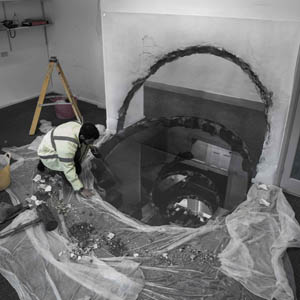Diploma Unit 9 thrives on the looping consequences of architecture’s own stories about itself. This year the ‘ruin’ was posed as a straightforward point of entry for a brief that would explore the ruin as an artefact and the embodiment of a cultural and architectural stagnation. Like last year’s exchange of the room and the city, this year’s work on the ruin led to the making of narratives within narratives, which demanded a comprehension of time and space as utterly elastic.
As Georges cut a series of holes through the physical spaces of the AA he confronted not only the physical exhaustion of a Georgian building, but also the discontinuities of the architectural conceit that makes up the corridor (which he demonstrated as an entity that does anything but connect).
Antoine battled an identity crisis on two fronts: the future of the European city and the future of the architect (and himself) in this unknown terrain. Both Antoine and Georges destroyed in order to build; yet neither conceded a return to the tabula rasa, which reveals itself today as its own kind of architectural ruin.
Ariadna’s project explores so many sub-narratives that we never know which story is the real one set in the place that still might be Manhattan. The project is at once a film as well as a set occupied by both buildings and their architect – a new, unexpected kind of built world. Meanwhile Eleanor battles with the axonometric, an architect’s text, and an architect who becomes, like Luke’s Darth Vader, a father she must destroy to find her place in an architectural world far, far away.
Our work on the ruin was a wipeout where cities that were once whole now stand as devastated landscapes. Through the settling dust we learned this: whatever the ruin may be, its inverse is unknowable – and within that ambiguity lies the potential for an architectural project and the possibility to locate the architect within this new context. It enables us to make work that is committed to what we do best – architecture about architecture.
Staff
Natasha Sandmeier
Special thanks to our guests and critics and support
Charles Arsène-Henry for his seminars and inspiration
Amandine Kastler
Ana Araujo
Andrew Yau
Barbara-Ann Campbell-Lange
Belinda Flaherty
Brett Steele
Christopher Pierce
Dolores Ruiz Garrido
Doreen Bernath
Evan Greenberg
Fabrizio Ballabio
Francesca Hughes
Gabriela Garcia
de Cortazar G
Inigo Minns
Javier Castañón
Kenneth Fraser
Manolis Stavrakakis
Maria Fedorchenko
Marilyn Dyer
Marina Lathouri
Mark E Breeze
Mark Campbell
Mark Cousins
Martin Jameson
Matthew Butcher
Michael Weinstock
Nacho Marti
Ricardo de Ostos
Shin Egashira
Shumon Basar
Sylvie Taher
Takero Shimazaki
Tarek Shamma
Theodore Spyropoulos
Thomas Weaver
Tyen Masten
Georges Massoud
This project challenges the forms of connectivity conventionally understood as the corridor or the open plan. It argues the conventional manifestations of connectivity as an object is the corridor and as an image is the open plan. We have collectively relied on the corridor as a connector however it is not its form that is the enabler. The reason the corridor exist is because of the value we have given to circulation. Both the corridor and the re-corridorisation of the open plan have proven to us that connectivity is distinctively different from circulation. Our frame of perspective must change: as a form of representation and as a conceptual ground. The project challenges the failed forms of connectivity and proposes to strip the concept of any preconceived forms.
The concept of connectivity is challenged on three planes of existence that sit within the 2-dimensional realm using "the hole" as a device. The hole is used as both a concept and real material state challenging conditions of isolation and segregation within this fictional journey of outdated forms of connectivity.
There are three planes of existence and each mode of representation is a way into a certain aspect of the project. The first 2 planes: evidence of the hole and evidence of making the hole reassure us of its existence. The third plane is the one that exposes the hyper artificiality of the hole and its existence only as an image: the paper hole.
Without addressing connectivity architecture is reduced to its material forms. We must broaden our scope to allow for all these plastic associated qualities to relate to other cultural context. Through shifting perspectives, the real, the theatrical and the paper turn material into theatre allowing it to do much more.


































































